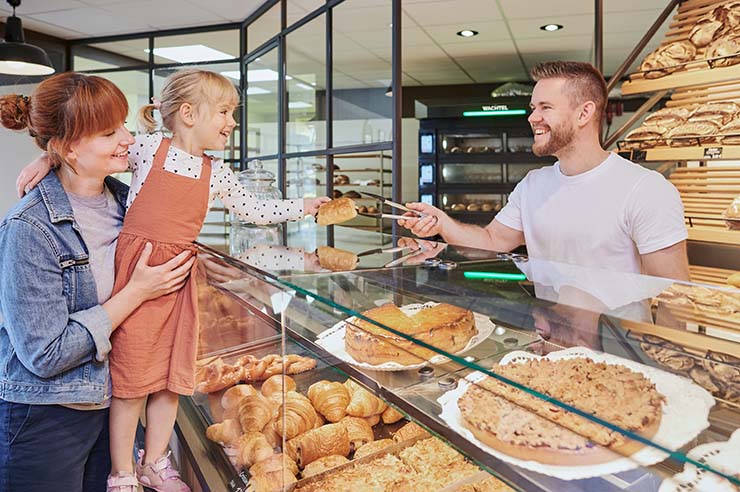
Smart devices are quickly becoming an indispensable part of life inside the baking shop as they are on the outside. For in-store ovens, smart tools are being developed to make them more efficient and easier to operate for consistent results. Some of the industry’s leading technology suppliers share their solutions.
Baking in-store not only brings the entire process in view of the consumers but also invites a warm connection. High-quality results will, naturally, only consolidate this relationship. To achieve this, there is a long list of requirements that in-store ovens should meet.
Baking premium, in-store: WP BAKERYGROUP
An in-store oven should always be able to bake fresh dough pieces into products of consistent quality, similar to those baked in the central bakery, WP BAKERYGROUP notes. On the software side, the oven control system must have the possibility of storing baking programs that – after a simple selection procedure – will automatically control all parameters during baking. Once the recipes are stored in the baking program control system (by a trained baker), the baking programs can be used to bake with the same quality results time and time again.
The user interface takes into account that even non-professionals should easily use it; the desired baking program must be easy to select and displayed via product photos, for example. It should also include information about the status of the oven, whether it has reached the baking temperature, and then display the remaining baking time once baking starts. The end of the baking process should also be clearly signaled, the specialist details. Other useful options include the possibility of programs starting during the night, as well as the automated shutdown when the oven has not been used for a pre-defined, extended period of time.
The most frequent product quality variations occur when dough pieces are introduced too early for baking, before the optimum baking temperature has been reached. “This should therefore be clearly shown on the display, e.g. in the form of a traffic light,” the specialist highlights.
Most inquiries for in-store ovens the company receives are for deck ovens, to bake premium products. In this category, the MATADOR® oven was designed around one core requirement: uniform baking results, consistently, which it achieves with an intelligent heating system. It runs with the WP BakeryControl software, which helps control baking sequences according to the oven’s capacity utilization, contributing to extending shelf-life at the same time. It also includes features for recipe management, baking sequence optimization, monitoring and (remote) diagnosis. “The oven control system must be able to bake all baked products, in principle. This requires a sufficiently large baking program memory that makes the required baking technology available at any time,” Dr.-Ing. Adams summarizes.
Another option available in the WP NAVIGO II PROFI-CONTROL is the WP INTELLIGENT ENERGY CONTROL feature, which helps to minimize the energy loss the MATADOR® could have in between baking batches, via the ‘stand-by’ function.
Premium results
For traditionally challenging, premium products that are increasingly popular, the leading role belongs to the master baker, to identify the process that best serves the recipe and product demands.“The oven manufacturer has to provide a professional oven on which the baker can set and program all baking parameters accordingly. The control system ensures reproducible quality, even if the operator is not a trained baker,” he adds.
Looking to the future of smart in-store oven technology is, without a doubt, looking into sustainability and optimizing the efficiency of the process. “The energy required for baking depends only on the baked product itself, not on the oven,” Dr.-Ing. Adams points out. However, the oven must provide the required heat energy from the available energy sources, be it electricity, oil or gas. “Since electricity is used in most cases in the in-store area, efficiency is particularly high here, at 100%, since all the electrical energy supplied is converted into heat via the heating elements (electrical resistances),” the expert argues. Losses that might occur as the heat dissipates from the oven can be countered with good insulation. Working with steam, which is absolutely necessary for baking quality, also entails energy losses, since water evaporation requires a lot of energy and the generated steam eventually leaves the oven again. “Therefore, by reducing the volume of steam step-by-step, an attempt should be made to steam as little as possible so that the desired baking quality is just achieved,“ he recommends. The energy required for baking depends, for the most part, on the baked product itself and only for a small part on the baking oven.
“The energy required for baking depends only on the baked product itself, not on the oven.“
Dr.-Ing. Christoph Adams, WP Lebensmitteltechnik GmbH

The article is part of an extended feature, which was originally published in [BBI 1 – 2022]. Read the full article in the magazine:


